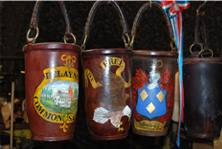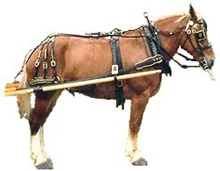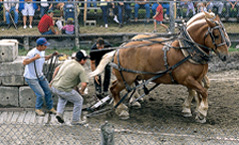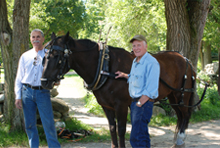Craft Traditions – Harness Making
Up until the early 1900s people used oxen and draft horses for farm work, logging, transportation, and hauling things from place to place. Oxen were used by early settlers to clear land and farm. Draft horses became more popular in the 1800s.
Draft horses are much larger than standard riding horses. They are smart, strong, and can be hitched up into teams of two or more for heavy, long distance hauling.
A well made harness is essential for working with a draft horse. A harness consists of a network of leather straps, buckles, loops, and lines fitted to the horse and attached to what needs to be pulled, whether it be a cart, wagon, a load of logs, a plow, or other heavy equipment.

Traditional fire buckets made by
Russell Bigelow.
In the 1800s, the harness maker was the "auto mechanic" of his day. Many New Hampshire towns had several harness makers and they were kept busy making and repairing harnesses.
Harness makers made other things out of leather too, like caps, small cases for storing papers and large trunks for traveling. In the Colonial days, they also made leather fire buckets. Each house had one for putting out fires.
A harness begins with straps that go around the horses head called the bridle. For heavy hauling, a draft horse wears a thick padded collar. Every collar is fitted to a particular horse. If you sell a draft horse, the collar goes with it!

Express horse harness.
On either side of the collar are wooden or metal bars called hames. Leather straps, called traces, run from the hames to the load. On an express harness, made for a single horse, the traces usually connect directly to the load.
A single draft express horse harness may have as many as 36 pieces, not including the collar, and take weeks to make. Three or four types of leather, each type suited to the needs of a particular part of the harness are used.
With a team of two or more horses, the traces run to a wooden or metal bar in back of the horses called an evener, a singletree or a whippletree, depending upon what part of the country you live in. The evener helps to distribute the weight of the load, which makes it easier for the horses to pull. Straps are also fitted over the hindquarters of the horse and are called breeching. They enable the horse to step backwards into the weight of a load to slow it down.

Horse pulling at the Lancaster Fair.

Master harness maker
Russell Bigelow (right) with
apprentice Kieth LaRiviere
and a completed express
horse harness modeled by
Leo, a Percheron draft horse
and retiree from
Arlington National Cemetery
in Washington, DC.
Today, there are only a few skilled craftsmen who preserve this important tradition. Many are in the Amish country of Pennsylvania and we have a few in New England. Their work is treasured by people who raise, train, and work with draft horses.
Photo credit: Lynn Martin Graton
New Hampshire State Council on the Arts
19 Pillsbury Street - 1st Floor, Concord, NH 03301


